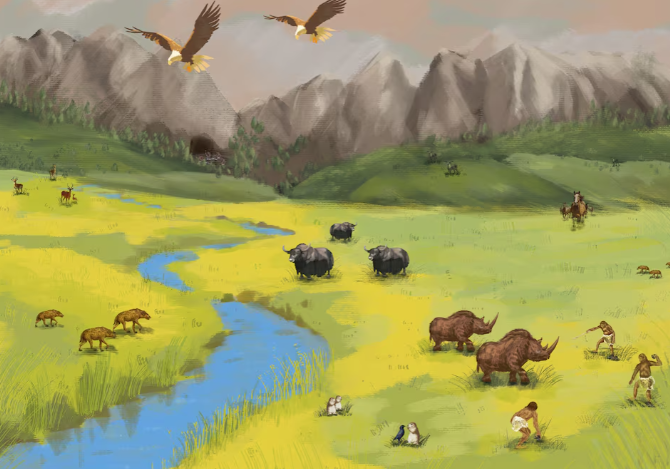
New study sheds light on lifestyle of enigmatic extinct humans
Thousands of bone fragments discovered in a cave on the Tibetan Plateau in China are offering rare insight into the lives of Denisovans, the mysterious extinct cousins of Neanderthals and our own species, showing they hunted a wide range of animals from sheep to woolly rhinoceros in this high-altitude abode. Researchers studied more than 2,500 bones found inside Baishiya Karst Cave, which is situated 10,760 feet (3,280 meters) above sea level and previously had yielded Denisovan fossil remains. They used ancient protein analysis on these remains to reveal that the Denisovans exploited various animals for their meat and skins, and also excavated and identified a rib bone from a Denisovan individual dating to 48,000-32,000 years ago - the youngest Denisovan fossil yet known. Most of the bones were identified as belonging to blue sheep, also called bharal, a goat species still seen on high slope mountains and cliffs in the Himalayas. Other bone remains came from woolly rhinos, yaks, small mammals like marmots, birds, and even from the spotted hyena, a large carnivore that prowled the region called the Ganjia Basin. It was a grass landscape with small forested areas, teeming with life despite harsh conditions. The animals were butchered for meat, based on cut marks found on various bones, and there was evidence of bone marrow extraction and skinning activities. The researchers also found four tools fashioned from animal bone, shaped for use in processing animal carcasses. "It is the first time we have gotten an understanding of the subsistence behaviors of Denisovans, and it shows us they were highly capable of accessing and utilizing a wide range of animal resources," said University of Copenhagen molecular anthropologist Frido Welker, one of the leaders of the research published on Wednesday in the journal Nature, opens new tab. "I think the diverse animal remains found in Baishiya Karst Cave suggest that this location offered relatively better resources compared with the neighboring higher Tibetan Plateau to the west and the Chinese Loess Plateau to the north, especially in the glacial period," said archeologist Dongju Zhang of Lanzhou University in China, another of the study leaders. The existence of Denisovans was unknown until researchers in 2010 announced the discovery of their remains in Denisova Cave in Siberia, with genetic evidence showing them to be a sister group to Neanderthals, the stoutly built extinct archaic humans who inhabited parts of Eurasia. Both experienced significant interactions with Homo sapiens, including interbreeding, before vanishing soon after for reasons not fully understood. "From genetics, we know they diverged from Neanderthals around 400,000 years ago," Welker said. Denisovans are known only from dental remains and bone fragments from the Baishiya Karst and Denisova caves and Cobra Cave in Laos, though their existence at those three far-flung locations demonstrates a wide geographic dispersal.

Thousands of bone fragments discovered in a cave on the Tibetan Plateau in China are offering rare insight into the lives of Denisovans, the mysterious extinct cousins of Neanderthals and our own species, showing they hunted a wide range of animals from sheep to woolly rhinoceros in this high-altitude abode. Researchers studied more than 2,500 bones found inside Baishiya Karst Cave, which is situated 10,760 feet (3,280 meters) above sea level and previously had yielded Denisovan fossil remains. They used ancient protein analysis on these remains to reveal that the Denisovans exploited various animals for their meat and skins, and also excavated and identified a rib bone from a Denisovan individual dating to 48,000-32,000 years ago - the youngest Denisovan fossil yet known. Most of the bones were identified as belonging to blue sheep, also called bharal, a goat species still seen on high slope mountains and cliffs in the Himalayas. Other bone remains came from woolly rhinos, yaks, small mammals like marmots, birds, and even from the spotted hyena, a large carnivore that prowled the region called the Ganjia Basin. It was a grass landscape with small forested areas, teeming with life despite harsh conditions. The animals were butchered for meat, based on cut marks found on various bones, and there was evidence of bone marrow extraction and skinning activities. The researchers also found four tools fashioned from animal bone, shaped for use in processing animal carcasses. "It is the first time we have gotten an understanding of the subsistence behaviors of Denisovans, and it shows us they were highly capable of accessing and utilizing a wide range of animal resources," said University of Copenhagen molecular anthropologist Frido Welker, one of the leaders of the research published on Wednesday in the journal Nature, opens new tab. "I think the diverse animal remains found in Baishiya Karst Cave suggest that this location offered relatively better resources compared with the neighboring higher Tibetan Plateau to the west and the Chinese Loess Plateau to the north, especially in the glacial period," said archeologist Dongju Zhang of Lanzhou University in China, another of the study leaders. The existence of Denisovans was unknown until researchers in 2010 announced the discovery of their remains in Denisova Cave in Siberia, with genetic evidence showing them to be a sister group to Neanderthals, the stoutly built extinct archaic humans who inhabited parts of Eurasia. Both experienced significant interactions with Homo sapiens, including interbreeding, before vanishing soon after for reasons not fully understood. "From genetics, we know they diverged from Neanderthals around 400,000 years ago," Welker said. Denisovans are known only from dental remains and bone fragments from the Baishiya Karst and Denisova caves and Cobra Cave in Laos, though their existence at those three far-flung locations demonstrates a wide geographic dispersal.
